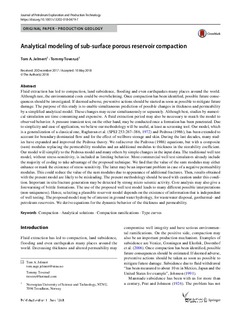| dc.description.abstract | Fluid extraction has led to compaction, land subsidence, flooding and even earthquakes many places around the world. Although rare, the environmental costs could be overwhelming. Once compaction has been identified, possible future consequences should be investigated. If deemed adverse, preventive actions should be started as soon as possible to mitigate future damage. The purpose of this study is to enable simultaneous prediction of possible changes in thickness and permeability by a simplified analytical model. These changes may occur simultaneously or separately. Although best, studies by numerical simulation are time consuming and expensive. A fluid extraction period may also be necessary to match the model to observed behavior. A pressure transient test, on the other hand, may be conducted once a formation has been penetrated. Due to simplicity and ease of application, we believe our methodology will be useful, at least as screening tool. Our model, which is a generalization of a classical one, Raghavan et al. (SPEJ 253:267–386, 1972) and Pedrosa (1986), has been extended to account for boundary dominated flow and for the effect of wellbore storage and skin. During the last decades, many studies have expanded and improved the Pedrosa theory. We rediscover the Pedrosa (1986) equations, but with a composite (sum) modulus replacing the permeability modulus and an additional modulus to thickness in the storability coefficient. Our model will simplify to the Pedrosa model and many others by simple changes in the input data. The traditional well test model, without stress-sensitivity, is included as limiting behavior. Most commercial well test simulators already include the majority of coding to take advantage of the proposed technique. We find that the value of the sum modulus may either enhance or mask the existence of stress-sensitivity. The latter may be an important problem in case of a negative permeability modulus. This could reduce the value of the sum modulus due to appearance of additional fractures. Then, results obtained with the present model are likely to be misleading. The present methodology should be used with caution under this condition. Important in situ fracture generation may be detected by strong micro seismic activity. Core analysis may also give a forewarning of brittle formations. The use of the proposed well test model leads to many different possible interpretations (non-uniqueness). Hence, selecting a plausible reservoir model depends on the existence of information that is independent of well testing. The proposed model may be of interest in ground water hydrology, for wastewater disposal, geothermal- and petroleum reservoirs. We derive equations for the dynamic behavior of the thickness and permeability. | nb_NO |

